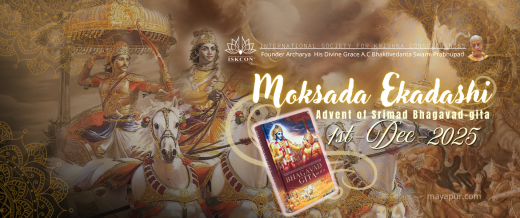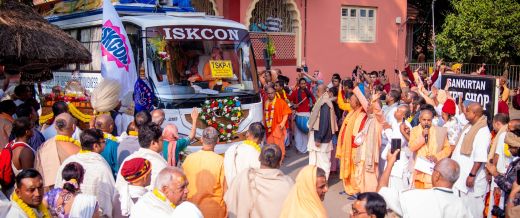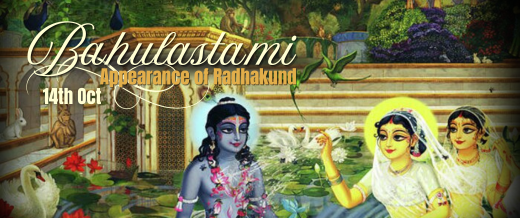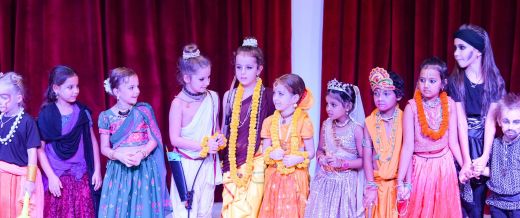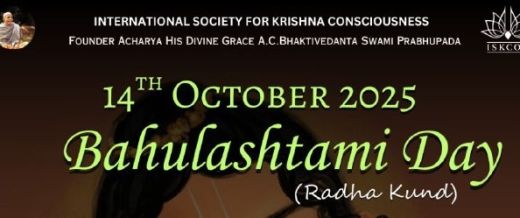Gaura Purnima Festival Schedule 2026
Over 500 years ago, in the sacred land of Navadvīpa, the Supreme Personality of Godhead, Śrī Krishna, appeared as Śrī Caitanya Mahāprabhu. Taking on the golden hue of Śrīmatī Rādhārāṇī, He descended to distribute the yuga-dharma—the congregational chanting of the holy names. Through His boundless compassion, He transformed hearts through kīrtana, love, and devotion, opening the doors of bhakti to the entire world.
Śrīla Prabhupāda repeatedly expressed his heartfelt desire:
that all devotees gather every year in Śrī Māyāpur-dhāma—especially during the time of Gaura Pūrṇimā—to receive mercy, recharge spiritually, and deepen their connection with the mission of Lord Caitanya.
Following in his footsteps, we extend a warm and loving invitation to you and your family to join us for:
GAURA PŪRṆIMĀ FESTIVAL 2026
31 January – 5 March · Śrī Māyāpur Candrodaya Mandir
| Date | Event |
|---|---|
| 31st January | Śrī Nityānanda Trayodaśī |
| 04th – 14th February | GBC Plenary, SGGS |
| 06th February | 152nd Appearance Day of Śrīla Bhaktisiddhānta Sarasvatī Ṭhākura Prabhupāda |
| 08th February | Devotees Arrival |
| 09th February | Śrīla Prabhupāda Connect Day (English/Russian) |
| 10th – 12th February | Śravaṇa Utsav |
| 11th February | Yajña Shala Inauguration at TOVP |
| 13th February | Ekādaśī, Festival Inauguration (Garuda–Dhvajā) Flag Hoisting, Deity Report (Morning), GBC Istāgoṣṭhī & Kīrtana Melā Adhivāsa |
| 14th – 18th February | Kīrtana Melā |
| 14th February | SGGS & Māyāpur Saṅkīrtana Book Distribution Awards |
| 16th February | Śrī Śiva–rātri at ISKCON Rājāpur, Śrī Jagannātha Temple, World Saṅkīrtana Book Distribution Awards |
| 18th February | Navadvīpa Maṇḍala Parikramā Adhivāsa at YOGAPĪṬHA |
| 19th – 25th February | Navadvīpa Maṇḍala Parikramā |
| 26th February | Parikramā Mahāmilan |
| 26th February to 2nd March | Cultural Programs |
| 27th February | Ekādaśī, Śrīmad Bhāgavatam & Śrī Caitanya–caritāmṛta Yajña, Śrī Śrī Rādhā Mādhava Boat Festival |
| 28th February | Govinda Dvādaśī, Śāntipura Festival |
| 01st March | Gaṅgā Pūjā, Immersion of Ashes |
| 02nd March | Gaura Pūrṇimā Adhivāsa, Śrīla Prabhupāda Connect Day (Bengali) |
| 03rd March | Appearance Day of Śrī Caitanya Mahāprabhu, Abhiṣeka & Ekādaśī Feast at Moonrise |
| 04th March | Jagannātha Miśra Festival Feast |
| 05th March | (Garuda–Dhvajā) Festival Flag Lowering Ceremony |
For guest House Booking
Rooms are filling quickly. Reserve early:
mghb108@gmail.com
For donations, sponsorships, and inquiries:
donorservices@mayapur.com
You may offer support for:
Prasādam distribution
Parikramā arrangements
Kīrtana Melā
Sravaṇa Utsav
Abhiṣeka & Festival Seva
General Gaura Pūrṇimā Festival support
Every contribution—large or small—is a direct service to Śrī Caitanya Mahāprabhu and deeply appreciated.
Come and immerse yourself in the spiritual atmosphere of Lord Caitanya’s eternal home, together with thousands of devotees from all over the world. Deepen your bhakti, and be part of the most cherished festival of the year.
Your servants,
ISKCON Śrī Māyāpur
Gita Jayanti - Even one Gita can change a life!
As we approach the sacred occasion of Gītā Jayanti on Mokṣadā Ekādaśī, our hearts naturally turn toward the divine moment when Lord Krishna personally spoke the Bhagavad-gītā to Arjuna. Srila Prabhupada reminds us:
“Because Bhagavad Gita is spoken by the Supreme Personality of Godhead, one need not read any other Vedic literature. One need only attentively and regularly hear and read Bhagavad Gita.”
For over 30 years—since 1994—the Bhaktivedanta Gita Academy (Mayapur) has been enriching countless lives through the teachings of the Bhagavad-gītā As It Is. Their courses, including the Gita Study Course and others, are carefully designed to benefit everyone—whether a newcomer or a seasoned practitioner. These systematic studies help devotees deepen, mature, and strengthen their Krishna consciousness in a heartfelt way.
We know the Bhagavad-gītā is widely known, yet often misinterpreted. Srila Prabhupada emphasized that his purports are not his own speculation but express the essence given by our previous ācāryas. Around 1970 in Indore, at a grand Gita Jayanti gathering with many speakers, Srila Prabhupada’s clear and authoritative presentation exposed the flaws of the mental speculators present there.
He powerfully instructed us:
“Anyway, print books, distribute profusely, and that will be the best preaching work. What will your three minutes’ preaching do? But if they buy one book, it may turn their life… Make this your important task, to print our books… and distribute widely… our process is slow but sure.”
Here in Sri Mayapur, Gita Jayanti is celebrated joyfully for three days—pandals, bookstands across the campus, harinam, and (especially) book distribution. On the main day, a fire yajña is performed while devotees chant all 700 verses of the Bhagavad-gītā. Visitors, residents, and pilgrims spend the day immersed in transcendental bliss.
This year, if you are not able to personally go out for book distribution, you can still fully participate by sponsoring Bhagavad-gītās for distribution in places where Krishna’s teachings have still not reached strongly. Your sponsorship ensures the Gita goes to villages, schools, remote locations, and receptive hearts waiting for Krishna’s words.
Even one Gita can change a life.
If you feel inspired, you can contribute here:
https://www.mayapur.com/festivals/Gita-Jayanti
Thank you for your kind-hearted support. May Sri Krishna bless you on this sacred Mokṣadā Ekādaśī with wisdom, devotion, and the joy of sharing His message.
Odana Sasthi Festival Schedule!
Hare Krishna dear devotees,
Please accept my humble obeisances. All glories to Srila Prabhupada.
We warmly invite you to join us in Rajapur on November 26th for the auspicious Odana Ṣaṣṭī Festival of Sri Sri Jagannath, Baladeva and Subhadra Devi. On this sacred day, the Lords receive Their first winter garment, a beautiful tradition lovingly described in Sri Caitanya-caritāmṛta. Remembering how Pundarika Vidyanidhi received special mercy on this day, we pray that this festival brings deep blessings to all our hearts.
Festival Schedule:
8:00 – Bhagavatam Class by HH Subhag Swami Maharaj
9:00 – Darshan Arati
9:30 – Drama, Śloka Offerings & Dances
11:00 – Bhajans
11:45 – Offering of Bhoga brought by devotees
12:00 – Kirtan till 1 PM
If you feel inspired to serve Their Lordships personally, you may sponsor any of the festival sevas. You can explore the options here:
https://www.mayapur.com/festivals/Odana-Sasti
Your heartfelt contribution helps keep this beautiful service to Lord Jagannath alive.
Hope to see you in Rajapur!
Your servant,
From Māyāpur to the World — The Mission Continues!
Vijaya Yātrā Praṣṭhān 2025!
Yesterday was a very special day here in Śrīdhāma Māyāpur. The temple was filled with colourful rangolis, joy, emotion, and a deep sense of purpose as we gathered for the Vijaya Yātrā Praṣṭhān — the official send-off for this year’s Sankīrtan party. Instead of the usual Śrīmad Bhagavatam class, the community came together to offer prayers, blessings, and encouragement to the devotees preparing to go out and distribute Śrīla Prabhupāda’s books during the annual book marathon.
The program began with a yajña, where everyone joined in prayers for protection and success. After that, we all took darśana and joined in āratī, filling the temple with kīrtan and heartfelt devotion. Senior devotees then spoke words of wisdom and inspiration, reminding us that book distribution is not just an activity — it is an act of compassion, a way of sharing Krishna with the world.
Here in Māyāpur, distributing Śrīla Prabhupāda’s books is at the very heart of our mission. Some devotees will travel across India, meeting people from all walks of life, while others will continue distributing books right here within the campus — but the mood remains the same: to give everyone an opportunity to come closer to Krishna.
Śrīla Prabhupāda often emphasized that if someone simply sees or holds one of his books, they receive benefit — and if they read it, their life can transform. So every book given is like planting a seed of bhakti in someone’s heart.
As the Sankīrtan team begins their journey, we send them forward with our prayers and gratitude. May Lord Caitanya, Lord Nityānanda, and Śrīla Prabhupāda guide them, protect them, and allow them to touch many hearts.
We look forward to welcoming them home again around Gaura Pūrṇimā, filled with realizations, mercy, and stories of how Krishna worked through them.
All glories to Śrīla Prabhupāda.
All glories to the Sankīrtan devotees.
Bhisma Panchak Begins!
Bhisma Panchaka in Mayapur! || How to observe Bhishma Panchaka
The last 5 days of the month of Karttika are traditionally known as the Bhishma Panchaka or the Vishnu Panchaka. Grandfather Bhisma fasted for these five days, preparing to give up his life. In the Hari BhaktiVilasa, it is said that if one is capable, one should observe fasting from certain foodstuffs on the Bhishma-panchaka for the pleasure of the Lord. This is optional. “The fast should begin by remembering Bhismadeva on the Ekadasi day and should end on Purnima [the full moon]. The Padma Purana say that one pleases the Lord and makes spiritual advancement by such austerities.
Various Levels of fasting:
Type 1
One can eat products of the cow for each day:
First day: Cow dung (Gomaya)
Second day: Cow urine (Go-mutra)
Third day: Cow milk (Kshiira)
Fourth day: Cow yoghurt (Dahi)
Fifth day: All products of the cow mixed (Pancha-gavya)
--------
Type 2
If one can’t follow level 1 then please take fruits and roots.
Fruits with lots of seeds should be avoided like guava, pomegranate, cucumber etc. Boiled potatoes, raw banana and sweet potato can be taken. We can use sea salt for taste. Cashewnuts (PLAIN) raisins, dates can be taken. Milk products to be avoided.
--------
Type 3
If one can’t follow level 2, one can take “Havishya.”
References: Padma Puraana, Brahma-khanda, Chapter 23; Skanda Puraana, Vishnu Khanda, Kaartika Maahaatmya section, Chapter 32; Garuda Puraana, Puurva Khanda, Chapter 123.
Ingredients for Havishya as mentioned in Sri Hari-bhakti-vilasa (13.10-13)
The following are ingredients that can be used in making Havishya, which is
like a khichari made with these items.
Aatap rice
Unadulterated Ghee from cow
Saindhava salt (sea salt)
Milk from cow
Milk with cream
Ripe Banana
Kaala-Shaaka
Wheat
Fruits (Skanda Puraana, Naagara Khanda says they must be with a small seed
or with few seeds only)
Mango
Jackfruit
Labali fruit
Roots except kesa grass root
Pippalii
Haritakii
Naagaranga
Ikshu-dravya or sugarcane derivatives (other than gur or mollasses)
No oil in any form
The following ingredients though part of Havishya need to be avoided in the month of Kartika:
Mung dal, Til oil, Beta-shaaka, Shashtikaa-shaaka, Radish, Jeeraa, Tamarind
--------
Special Offerings to the Lord during these days
Following flowers to be offered to the Deities during the Bhishma Panchaka days as per Garuda Purana.
First day: one must offer padma (lotus) flowers to the feet of the Lord.
Second day: one must offer bilva (wood-apple) leaves of the thigh of the Lord.
Third day: one must offer gandha (scents) to the navel of the Lord.
Fourth day: one must offer java flower to the shoulders of the Lord.
Fifth day: one must offer malati flower to the head (siro-desa) of the Lordship.
--------
Ideally, one should take bath in Ganges or the other holy rivers every day and offer tarpana 3 times for Bhismadeva by saying the following mantra:
Tarpana
om vaiyaghra padya gotraya
samkrti pravaraya ca
aputraya dadamyetat
salilam bhismavarmane
Arghya
vasunamavataraya
santanoratmajaya ca
arghyam dadami bhismaya
ajanma brahmacarine
Pranam
om bhismah santanavo birah
satyavadi jitendriyah
abhiradbhiravapnatu
putrapautrocitam kriyam
The Glorious Legacy of Our Eternal Founder-Acharya
Sri Mayapur Dham, the spiritual headquarters of the International Society for Krishna Consciousness (ISKCON), recently witnessed a heart-touching and memorable celebration of Srila Prabhupada’s Disappearance Day — a day that evokes both gratitude and reverence in the hearts of devotees worldwide.
A Morning of Love and Remembrance
The day began early at 7:00 a.m., as hundreds of devotees gathered to participate in a beautiful Harinam procession, carrying Srila Prabhupada’s murti on a gorgeously decorated palanquin. The procession gracefully made its way to the Srila Prabhupada Samadhi Mandir, accompanied by joyful chanting of the holy names, kartals, and mridangas that filled the air with transcendental vibration.
Devotees, godbrothers, disciples, well-wishers, and senior Vaisnavas walked together — each step offered in love and gratitude. The atmosphere was surcharged with devotion as flower petals showered the palanquin, honoring the great soul who brought Krishna consciousness to every corner of the world.
Remembering the Acharya Who Transformed the World
Throughout the celebration, everyone was reminded of the incredible contribution Srila Prabhupada made — not only to ISKCON, but to all of humanity. His compassion, courage, and dedication awakened spiritual consciousness globally, fulfilling Lord Caitanya Mahaprabhu’s prophecy that “in every town and village, the holy name of Krishna will be heard.”
Many senior devotees, disciples, well-wishers, and godbrothers shared heartfelt memories and realizations about Srila Prabhupada — each one a living testimony to his ongoing spiritual presence and the transformative power of his mission.
A Glimpse Into His Life Through Drama
In the afternoon session, the Mayapur Youth presented a captivating drama depicting the life of Srila Prabhupada — from his early years in Calcutta to his extraordinary journey across the seas and the establishment of ISKCON worldwide. The performance beautifully portrayed his faith, struggles, and surrender to Krishna, leaving everyone deeply inspired.
Honoring the Next Generation
A special highlight of the celebration was the award ceremony for Mayapur school children, recognizing their creativity, enthusiasm, and devotion. These competitions and activities were inspired and encouraged by HG Jamāshtami Prabhu, a dear disciple of Srila Prabhupada, who has been consistently guiding and urging that the children be actively engaged and carried along in such meaningful ways.
Under his inspiration, many children participated in art competitions, essay writing, reading sessions from Srila Prabhupada-lilamrta, and other devotional presentations, all centered on learning and nurturing seeds of devotion that will continue to blossom as they grow.
Evening of Devotion
As the sun began to set, the celebrations resumed at 5:00 p.m. with soulful kirtans, enlightening kathas, and a heartfelt offering of lamps. The temple courtyard glowed with hundreds of diyas, symbolizing the light of bhakti that Srila Prabhupada kindled in millions of hearts around the world.
His Eternal Presence in Mayapur
Though Srila Prabhupada’s physical presence departed this world in 1977, his spiritual presence continues to illuminate Mayapur and the hearts of devotees everywhere. His teachings, his books, and his example live forever, guiding generations on the path of bhakti.
“He lives forever by his divine instructions, and the follower lives with him.”
As the day concluded with the chanting of the holy names and the sweet remembrance of Srila Prabhupada, it was clear that he was truly there — smiling upon his spiritual family, pleased to see the mission of Lord Caitanya flourishing with such love and unity.
All Glories to Srila Prabhupada
All glories to His Divine Grace A.C. Bhaktivedanta Swami Srila Prabhupada, who gave the world the holy name, the light of divine knowledge, and the eternal hope of returning home, back to Godhead.
Sri Kshetra Parikrama 2025
We humbly invite all ISKCON devotees worldwide to join the 21st Sri Kshetra Parikrama — a sacred journey around the holy land of Sri Jagannath Puri Dham, personally walked by Sri Caitanya Mahaprabhu Himself.
This special Parikrama is a wonderful opportunity to remember the divine glories of Lord Jagannath and experience the mercy of Lord Gauranga amidst inspiring kirtans, enlightening talks, and the loving association of devotees.
For registerations, please contact your preferred group below!
Contact Details:
Bangla Group – ISKCON Mayapur: 9434140178 / Mayapur Namahatta: 6295353278
skpbanglagroup@gmail.com
Hindi Group – 9593648074
skphindigroup@gmail.com
Odia Group – 9437264454
hemaharipada.jps@gmail.com
South Indian Group – 9232253602
skpsouthindiangroup@gmail.com
We look forward to your blessed participation in this beautiful offering of devotion.
The Appearance of Sri Radhakund and the story of Bahula!
“Of the many objects of favored delight and of all the lovable damsels of Vraja, Srimati Radharani is certainly the most cherished object of Krishna’s love. And, in every respect, Her divine Kunda is described by great sages as equally dear to Him. Indeed, Radha-kunda is rarely attained even by the great devotees; therefore, it is even more difficult for ordinary devotees to achieve. If one simply bathes once in these sacred waters, pure love for Krishna is awakened within the heart.”
— The Nectar of Instruction, Verse 11
Sri Radha-kunda manifested on the eighth day of the waning moon in the month of Kartik. This sacred day is observed by bathing in the holy waters at midnight — the very time when Radha-kunda appeared. On this night, thousands of devotees gather on the banks of Radha-kunda in Vrindavan to celebrate. They offer not only gifts like water, milk, fruits, sweets, garlands, lamps, and donations, but also their minds, bodies, and souls in loving devotion. United in prayer, they glorify Sri Radha-kunda, who is non-different from Srimati Radhika Herself.
In his purport to Srimad Bhagavatam (10.36.16), Srila Visvanatha Cakravarti Thakura beautifully describes the divine pastime of the appearance of Radha-kunda.
The appearance of Radha-kunda is also known as Bahulastami, named after the sacred pastime of the cow Bahula who took shelter of Lord Krishna. Near Krishna-kunda in Vrindavan, one can see the deities of a cow and her calf, a brahmana, a tiger, and Lord Krishna — commemorating this beautiful story.
Once, while the cow Bahula was peacefully grazing, a tiger suddenly attacked her. Bahula humbly requested the tiger to allow her to return to her calf, feed it, and bid farewell before surrendering herself. Moved by her sincerity, the tiger agreed. Bahula went to her master, a brahmana, and her calf, explaining what had happened. Out of compassion, both the brahmana and the calf offered to go in her place as the tiger’s meal. Despite their pleas, Bahula refused, but ultimately, all three — the cow, calf, and brahmana — went together to the tiger, ready to sacrifice themselves.
As the tiger pondered which to eat first, Lord Krishna, the protector of Dharma and all the residents of Vraja, appeared before them, holding His chakra. He blessed the tiger, assuring him of eternal fame if he spared the innocent cow and her kin. The tiger released Bahula, and all were overjoyed by Krishna’s merciful intervention.
Pleased with Bahula’s truthfulness and purity, Krishna named that forest Bahulavan and blessed her to become His consort. In her next life, Bahula indeed became one of Krishna’s wives. Thus, this sacred day came to be known as Bahulastami.
Bahulavan is considered by many Vaisnavas to be the most sacred of all forests, for within it lies the holiest place — Sri Radha-kunda. Srila Rupa Goswami, in Sri Upadesamrta, confirms the supreme position of Radha-kunda with the following verse:
“The holy place known as Mathura is spiritually superior to Vaikuntha because the Lord appeared there. Superior to Mathura is the transcendental forest of Vrindavan, the site of Krishna’s rasa-lila pastimes. Higher still is Govardhana Hill, raised by Krishna’s divine hand and witness to His loving exchanges. Yet, above all, the super-excellent Sri Radha-kunda stands supreme, overflowing with the ambrosial nectar of Sri Krishna’s prema.”
In Sri Navadvipa-dhama, Sri Radha-kunda has manifested Herself in two locations — on the islands of Rtudvipa and Antardvipa.
In Navadvipa-bhava-taranga, Srila Bhaktivinoda Thakura describes Lord Chaitanya Mahaprabhu’s mood as He visited Rtudvipa:
ritudvipam tato gatva
drishtva sobham vanasya ca
radha-kundadikam smritva
ruroda saci-nandanah
“Upon arriving in Rtudvipa and seeing the beauty of the forest, Saci-nandana (Sri Chaitanya) began to cry, remembering Radha-kunda and other sacred places.”
In Antardvipa, within the home of Chandrasekhar Acharya, Mahaprabhu’s maternal uncle, stands Sri Chaitanya Math — the headquarters of the Gaudiya Math established by Srila Bhaktisiddhanta Sarasvati Thakura. Following his guidance, disciples brought sacred waters from Radha-kunda and Syama-kunda, Giriraja silas from Govardhana Hill, and Tamala and Keli Kadamba trees from Vrindavan. Through his deep meditation and devotion, Srila Bhaktisiddhanta Sarasvati Thakura perceived these sacred places as being fully manifested within the Math.
All glories to the divine appearance of Sri Radha-kunda — the holiest of all holy places!
References:
Sri Upadesamrta, Srimad Bhagavatam 10.36.16 (purport), Navadvipa-dhama-mahatmya (Pramana-khanda 4.44), Nava Vraja Mahimamrta, Vol. 2 by Sivarama Swami, and Vedabase.
A Glimpse Śrī Rāmacandra Vijayotsava in Śrīdhāma Mayapur !
Recently, in Śrīdhāma Mayapur joyfully we celebrated the auspicious festival of Śrī Rāmacandra Vijayotsava — commemorating Lord Rāmacandra’s glorious victory over Rāvaṇa, symbolizing the eternal triumph of dharma over adharma, and light over darkness.
As part of the celebration, the Mayapur community children presented a heart-touching drama depicting the divine pastimes of Lord Rāmacandra. With adorable costumes and sweet devotion, they beautifully enacted scenes from the Rāmāyaṇa — from Lord Rāma’s battle with Rāvaṇa, to the moment Lakṣmaṇa was struck by Indrajit’s weapon, and how Hanumān heroically flew to the Gandhamādana mountain to bring the Sañjīvanī herb, reviving him.
The performance, held in the Mayapur Theater near Śrīla Prabhupāda’s Samādhi, was live-streamed on Mayapur TV, allowing devotees across the world to relish the sweetness of this offering. The children’s innocent expressions and heartfelt devotion reminded everyone of the timeless beauty of Lord Rāma’s story and His divine qualities of compassion, righteousness, and unwavering love.
Adding to the festive joy, there was a beautiful procession within the Mayapur campus, where the deities of Lord Rāmacandra, Lakṣmaṇa, Sītā, and Hanumān were taken on parikrama amidst Harinām saṅkīrtana, melodious chanting, and joyful glorifications. The air was filled with the holy names and the sound of kartāls and mṛdaṅgas as devotees danced in bliss.
This annual ritual is a cherished tradition in Mayapur, where, on each Appearance Day, the deities are lovingly taken around the campus — a sight that fills every heart with devotion and joy. This year’s Rāmacandra Vijayotsava was no exception — a truly uplifting and blissful day, uniting everyone in the spirit of love, service, and remembrance of Lord Rāma’s divine victory.
May Lord Rāmacandra bless us all with strength, virtue, and devotion to always walk on the path of dharma.
Kartik Special - Gaura Mandal Day Tour!
Step into the sacred land of Mahaprabhu’s Sannyas
Akai Hata – Kala Krishna Das Samadhi
Nupur Kund – Raghunandan Das Thakur Lila Sthan
Madhai Tala – Jagadananda & Madhavananda (Jagai-Madhai) Bhajan Kutir
Jajigram – Sripat of Srinivas Acharya, Narottam Das Thakur & Ram Chandra Kaviraj
Breakfast and lunch prasad.
15th October 2025 – Saints’ Abodes
Receive the mercy of great Vaishnava acharyas
Shantipur – Advaita Acharya Residence
Phulia – Haridas Thakur Bhajan Kutir
Birnagar – Bhaktivinod Thakur Birthplace
Breakfast and lunch prasad.
17th October 2025 – Ekachakra Yatra
DAY 1
Pastimes of Lord Nityananda Prabhu
Bargacchi – Nitai Vivaha Adivas Sthan
Balasa – Miniketan Ramdas Sripat
Ekachakra – Night Stay
Day 2
Mangaldighi – Panuya Gopala Sripat
Jalundi – Dhananjay Pandit Sripat
2 Breakfast, 2lunch, dinner prasad and accommodation
19th October 2025 – Kulai Tour
Discover the birthplace of the three Ghosh brothers
Madhava Ghosh, Vasudeva Ghosh & Govinda Ghosh
Kesava Bharati residence & Sonarundi Palace
Uddharana Thakur’s worshippable Gaura-Nitai deities
CC Ādi 11.18-19
“Śrī Mādhava Ghoṣa was a principal performer of kīrtana. While he sang, Nityānanda Prabhu danced. When Vāsudeva Ghoṣa sang, even wood and stone would melt upon hearing it.”
Breakfast and lunch prasad.
31st October 2025 – Panihati Yatra
Day 1
Raghav Bhavan
Ganga Ghat
Night Stay at Panihati
Day 2
Ariadaha – Dasa Gadadara Sripat
Barahanagar – Sri Raghunatha Bhagavata
Vallabhapura – Radhavallabha Vigraha
Khardaha – Darshan of original deities established by Vir Chandra Prabhu
2 Breakfast, 2lunch, dinner prasad and accommodation
Limited seats available – Book now!
WhatsApp: 7063573959

